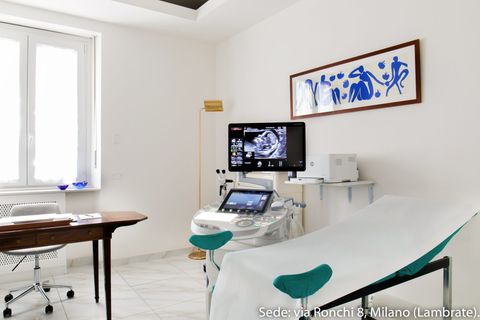PRENATAL SCREENING TESTS IN MILAN
BITEST / COMBINED TEST / DUOTEST / DUALTEST / ULTRASCREEN

WHAT IS IT FOR?
The Bi-Test / Combined Test / DuoTest is a screening test of the first trimester of pregnancy; it is noninvasive, therefore, poses no danger to the baby and mother or risk of miscarriage. It can be requested by all pregnant women.
It offers chromosomal risk assessment (specifically, Trisomy 21 - Down syndrome -, Trisomy 18 - Edwards syndrome - and Trisomy 13 - Patau syndrome -) with 90 to 95 percent reliability. And it can also be a telltale sign of congenital heart disease, fetal malformations, skeletal abnormalities and some genetic syndromes.
WHEN TO PERFORM IT ?
It is performed between 10 weeks (collection only) and 11-13 weeks + 6 days (collection and ultrasound), when the embryo measures between 45 and 84 mm.
PREPARATION
Fasting is not required for blood sampling. No preparation is required for ultrasound.
WHAT IS IT?
It consists of a maternal abdominal ultrasound to calculate the nuchal translucency (the thickness of a small layer of fluid located between the skin and the spine at the level of the nape of the fetus' neck, whose increased thickness correlates with chromosomal alterations) and a blood draw to the mother for the assay of two substances in maternal blood: PAPPA (pregnancy-associated plasma protein A) and β-hCG (free beta fraction of chorionic gonadotropin), which are produced by the feto-placenta unit. The combined performance and evaluation of these two tests allows the formulation of a risk in probabilistic terms that is quite sensitive and specific.
Calculation of the statistical risk of the child carrying chromosomal abnormalities is done by software that takes into account fetal nuchal translucency, PAPP-A and hCG and gestational age, maternal age, weight, smoking habits, previous pregnancies, ethnicity, and any medically assisted procreation methods. The final result is expressed as a risk in statistical percentage terms, is a risk index expressed as a percentage, compared with an established cut-off. Therefore, it is important to reiterate that we are talking about reliability and probability of risk, not certainty: negativity reduces the risk but does not cancel it, while positivity does not necessarily imply that the fetus is affected by disease. In practice, a negative outcome reduces the risk but does not cancel it out. Instead, if the risk is higher, then the screening is considered positive and the woman can consider further testing, such as villocentesis or amniocentesis. Even a positive result does not necessarily imply that the fetus is affected by the chromosomal alteration; therefore, too much anxiety and worry should be avoided, as the test gives a false-positive result in 5 percent of cases and, moreover, in Italy, a Down syndrome child is born only for every 1200 births; while Edwards syndrome has a prevalence of as low as 1 in 7900 live births. Therefore, a "pathological" result requires confirmation by invasive techniques (villocentesis or amniocentesis), while a normal outcome does not exclude the birth of a baby with Down syndrome or Edwards syndrome.
In addition, the ultrasound value of nuchal translucency may be higher than expected for that time of pregnancy and, therefore signal an increased risk of chromosomal alterations, possible malformations, especially cardiac. When the nuchal translucency is increased but the fetal chromosomes are normal, it is advisable to perform fetal echocardiography between 18 and 20 weeks and a level 2 ultrasound between 19 and 21 weeks of pregnancy to rule out other abnormalities.
Book an ultrascreen
OUR OFFICES
CHOOSE WHERE TO TAKE THE EXAMINATIONS
MILAN:
- Studio Ginecologico Milano, in Via Ronchi 8, mezzanine floor, in front of train station exit and metro Lambrate, Side via Rombon. Access for people with disabilities. MELEGNANO:
- Medical office located downtown at 63 Castellini Street, staircase f, 9th floor, 3 elevators present, access for people with disabilities.







